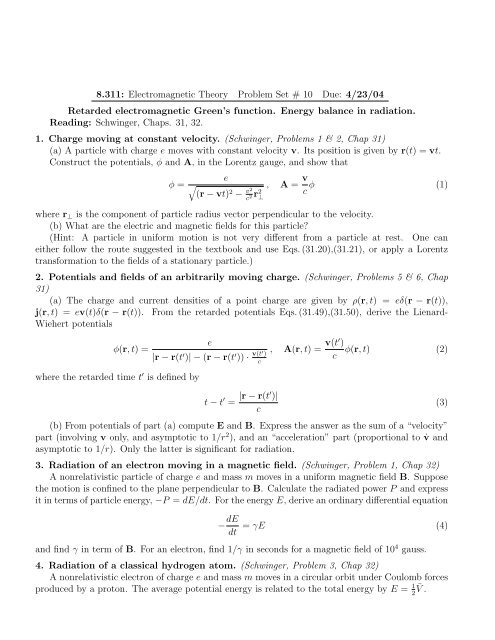8.311: Electromagnetic Theory Problem Set # 10 Due: 4/23/04 ...
8.311: Electromagnetic Theory Problem Set # 10 Due: 4/23/04 ...
8.311: Electromagnetic Theory Problem Set # 10 Due: 4/23/04 ...
You also want an ePaper? Increase the reach of your titles
YUMPU automatically turns print PDFs into web optimized ePapers that Google loves.
<strong>8.311</strong>: <strong>Electromagnetic</strong> <strong>Theory</strong> <strong>Problem</strong> <strong>Set</strong> # <strong>10</strong> <strong>Due</strong>: 4/<strong>23</strong>/<strong>04</strong><br />
Retarded electromagnetic Green’s function. Energy balance in radiation.<br />
Reading: Schwinger, Chaps. 31, 32.<br />
1. Charge moving at constant velocity. (Schwinger, <strong>Problem</strong>s 1 & 2, Chap 31)<br />
(a) A particle with charge e moves with constant velocity v. Its position is given by r(t) = vt.<br />
Construct the potentials, φ and A, in the Lorentz gauge, and show that<br />
e<br />
v<br />
φ = , A = φ (1)<br />
v 2 2<br />
(r − vt) 2 c<br />
2 r<br />
− c<br />
⊥<br />
where r ⊥ is the component of particle radius vector perpendicular to the velocity.<br />
(b) What are the electric and magnetic fields for this particle?<br />
(Hint: A particle in uniform motion is not very different from a particle at rest. One can<br />
either follow the route suggested in the textbook and use Eqs. (31.20),(31.21), or apply a Lorentz<br />
transformation to the fields of a stationary particle.)<br />
2. Potentials and fields of an arbitrarily moving charge. (Schwinger, <strong>Problem</strong>s 5 & 6, Chap<br />
31)<br />
(a) The charge and current densities of a point charge are given ρ(r, by t) = eδ(r − r(t)),<br />
j(r, t) = ev(t)δ(r − r(t)). From the retarded potentials Eqs. (31.49),(31.50), derive the Lienard<br />
Wiehert potentials<br />
e v(t )<br />
φ(r, t) = , A(r, t) = φ(r, t) (2)<br />
v(t )<br />
| r − r(t ) | − (r − r(t )) ·<br />
c<br />
where the retarded time t is defined by<br />
c<br />
r − r(t )<br />
t − t = | | (3)<br />
c<br />
(b) From potentials of part (a) compute E and B. Express the answer as the sum of a “velocity”<br />
part (involving v only, and asymptotic to 1/r<br />
2 ), and an “acceleration” part (proportional v˙ to and<br />
asymptotic to 1/r). Only the latter is significant for radiation.<br />
3. Radiation of an electron moving in a magnetic field. (Schwinger, <strong>Problem</strong> 1, Chap 32)<br />
A nonrelativistic particle of charge e and mass m moves in a uniform magnetic field B. Suppose<br />
the motion is confined to the plane perpendicular B. to Calculate the radiated power P and express<br />
it in terms of particle energy, −P = dE/dt. For the energy E, derive an ordinary differential equation<br />
dE = γE (4)<br />
− dt<br />
4<br />
and find γ in term of B. For an electron, find /γ 1 in seconds for a magnetic field of gauss. <strong>10</strong><br />
4. Radiation of a classical hydrogen atom. (Schwinger, <strong>Problem</strong> 3, Chap 32)<br />
A nonrelativistic electron of charge e and mass m moves in a circular orbit under Coulomb forces<br />
1<br />
produced by a proton. The average potential energy is related to the total energy E = by ¯<br />
2<br />
V .
Suppose that, as it radiates, the electron continues to move in a circle, and calculate the power<br />
radiated, and thereby −dE/dt, as a function of E (the relation is no longer linear). Integrate this<br />
result and find how long it takes for the energy to change Efrom<br />
2 to E 1 .<br />
Show that the electron reaches the center in a finite time. Calculate how long it takes an electron<br />
to hit the proton if it starts from an initial radius r 0 = of <strong>10</strong> −8 cm. (This radiation instability of a<br />
classical atom was one of the reasons for the discovery of quantum mechanics.)<br />
5. Dipole radiation.<br />
(a) A nonrelativistic electron of charge e and mass m is driven by a timedependent electric field<br />
E = E 0 z cos ωt. Show that the radiation is given by that of an oscillating d(t) dipole = er(t), and<br />
find the angular distribution of radiated power averaged over oscil lation cycle.<br />
(b) A nonrelativistic electron of charge e and mass m moves in a uniform and constant magnetic<br />
field B. As in part a), show that the radiation is given by that of a rotating d(t) dipole = er(t), and<br />
find the timeaveraged radiated power angular distribution.

















